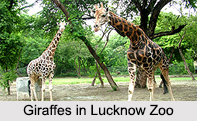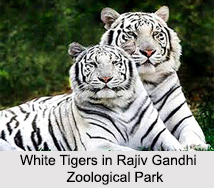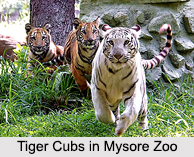 Zoos in India are known as `zoological gardens` and just like wildlife sanctuaries, zoos have the objective of preserving the flora and fauna present in the country. However, the main difference between these two is that, zoos keep animals in captivity and within artificially created habitat, whereas sanctuaries provide home to animals in their natural habitat without captivity. The zoos attract tourists and provide recreational facilities. Some of the zoos in India have earned recognition all over the world for their great collection of mammals, reptiles and birds. Given below are the Zoos in India.
Zoos in India are known as `zoological gardens` and just like wildlife sanctuaries, zoos have the objective of preserving the flora and fauna present in the country. However, the main difference between these two is that, zoos keep animals in captivity and within artificially created habitat, whereas sanctuaries provide home to animals in their natural habitat without captivity. The zoos attract tourists and provide recreational facilities. Some of the zoos in India have earned recognition all over the world for their great collection of mammals, reptiles and birds. Given below are the Zoos in India.
Zoos in Northern India
Manda Zoo is situated in Janipur in Jammu, Jammu and Kashmir. Some of the inmates of the zoo are animals like Himalayan black bear, leopard, barking deer and hog deer, reptiles like monitor lizard and birds like spot-billed duck, pangolin, cinerous vulture and black partridge . Chhatbir Zoo is located in Chhat Village, Zirakpur. Rohtak Zoo is located inside the Tilyar Lake Complex on Delhi Road in Rohtak. Tiger, leopard, fox, hyena and wolf are some of the animals of the zoo. Lucknow Zoo hosts about 57 species of reptiles, about 348 species of birds, about 447 species of mammals and about 97 varieties of animals. Some of the other Zoos in Northern India are Manali Zoo, National Zoological Park and Jaipur Zoo. 
Zoos of Western India
The Junagadh Zoo is located in Junagadh district and is renowned for Gir lions. Rajiv Gandhi Zoological Park was established in 1999. It houses a vast variety of reptiles, birds, mammals etc. Katraj Snake Park is well known for snakes and about 160 species of snakes have been identified here. Dadra and Nagar Haveli has a mini zoo, more specifically a deer park. It was established in the year 1987. Daman and Diu also has a mini zoo, more specifically a deer park. It was established in the year 1992. Some of the other Zoos of Western India are Kamla Nehru Zoo, Mumbai Zoo and Maharaj Baug and Zoo.
Zoos of Southern India
Karnataka houses one of the oldest and popular zoos in India, namely Mysore Zoo. It is located near a palace in Mysore. Indira Gandhi Zoological Park is located amidst Kambalakonda Reserve Forest in Visakhapatnam, Andhra Pradesh. It is regarded as the 3rd largest zoo in India. Nehru Zoological Park is housed in Hyderabad in Telangana. It was opened on 6th of October, 1963 and is spread over an area of about 380 acres. Some of the other Zoos of Southern India are Warangal Zoo, Thiruvananthapuram Zoo and Arignar Anna Zoologial Park. 
Zoos of Eastern India
Sanjay Gandhi Jaivik Udyan, also known as the Patna Zoo is located off Bailey Road in Patna. In the year 1973, this park was opened to the public. It is spread over a land of about 152.95 acres. Birsa Zoological Park is located near Ormanjhi, on the Ranchi-Patna National Highway. This park is associated with an animal adopting program, which aims to enhance public awareness regarding the importance of wildlife conservation. Nandankanan Zoological Park is located in Bhubaneswar. This zoo and botanical garden has the distinction of being the first zoo in India to join World Association of Zoos and Aquariums (WAZA) in the year 2009. Some of the Government Zoos of West Bengal are Alipore Zoological Garden, Adina Deer Park and Jhargram Deer. Some of the Private Zoos of West Bengal are Calcutta Snake Park, Marble Palace Zoo and West Bengal Snake Park and Laboratory.
Zoos of North East India
The Assam State Zoo cum botanical garden is located within the Hengrabari Reserved Forest in Guwahati. It was established in 1957. The Manipur Zoological Garden is located about 7 kms from Imphal. It was established on 2nd of October, 1976. Two other zoos of North East India are Nagaland Zoological Park and Tripura Zoo.















